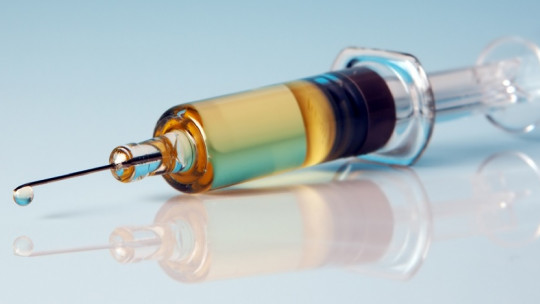Currently there are an infinite number of specific phobias registered related to all types of objects, behaviors, people or situations; some of them more unusual than others. Although most phobias do not always have to involve serious health consequences, there are specific cases in which they can end up causing other types of much more severe conditions.
This is the case of phagophobia , which we will talk about throughout this article and which can be associated with cases of anorexia and serious weight loss. Next, we will describe its main characteristics, symptoms, causes and possible treatments.
What is phagophobia?
Phagophobia falls within the category of specific anxiety disorders, also called specific phobias. Like the rest of phobias, it is characterized by the appearance of serious episodes of fear and anxiety when a specific stimulus appears. In this case fear is experienced before the act of swallowing
Like the rest of anxiety disorders caused by a specific stimulus, the person who suffers from phagophobia experiences a strong reaction of fear, accompanied by the physical manifestations of very high anxiety states
The main characteristics that distinguish a phobic fear are specified in the following points:
As a consequence and if no type of treatment is received, the patient can suffer severe complications related to a poor diet In some cases, phagophobia can lead to disinterest in food, severe weight loss, or anorexia.
Differences with other phobias
It is common that, at times, phagophobia is confused with other types of specific phobia such as pnigophobia or excessive fear of choking or drowning. Although they may seem very similar, both are already linked to the act of swallowing, in phagophobia the phobic stimulus is the mere act of swallowing, while In pnigophobia the fear lies in the possibility of choking and choking as a result of swallowing.
In both cases, the physical symptoms can be confused with those of other conditions such as dysgaphya and odynophagia, in which the person suffers from a psychological alteration that makes swallowing impossible or makes it very painful.
What symptoms does it manifest?
Because phagophobia is classified within the category of specific phobias, Its symptoms are similar to those of other anxiety disorders of this type The clinical picture of an anxious nature is characterized by the appearance of physical, cognitive and behavioral symptoms every time the person must face the feared act, in this case swallowing.
On some occasions, the phobia can be so deeply rooted that the patient manifests the symptoms only when thinking or imagining that they are swallowing any food, drink or even medication.
Therefore, in phagobobia the following symptoms will appear, which are ordered by categories:
1. Physical symptoms
Some of the first symptoms that the patient is aware of are physical or organic symptoms. These are due to hyperactivation of the nervous system in response to the appearance of the feared stimulus. As a consequence of this increase in functioning, all kinds of alterations and changes may appear in the body.
When these physical symptoms appear, the person may experience:
2. Cognitive symptoms
In addition to the physical symptoms, phagophobia is also characterized by the presence of a series of cognitive symptoms that manifest themselves through thoughts, beliefs and speculations regarding possible dangers that may appear or be related to the act of swallowing or swallowing.
These distorted or irrational ideas and beliefs drive the development of this phobia and are distinguished because the person integrates a series of illogical thoughts and imaginations that are constantly maintained in their mind.
3. Behavioral symptoms
Finally, like the rest of phobias, phagophobia also presents a series of behavioral symptoms. This symptomatology related to the person’s behavior manifests itself through avoidance behaviors and escape behaviors
In avoidance behaviors, the person carries out all types of acts or behaviors with the main objective of avoid encountering the phobic stimulus With them, he manages to avoid experiencing feelings of anguish and anxiety that this situation generates.
However, in the case of escape behaviors, these appear when the person has not been able to avoid the appearance of the feared situation, so they will carry out any type of act or behavior necessary to escape from the situation in which they find themselves. get wrapped up.
What causes does it have?
Discovering the origin of a phobia can be a really complicated task, since in many cases the person themselves is not able to determine what experience may have conditioned the appearance of said fear.
Despite this, it is known that there are various factors that can predispose or enhance the emergence and development of an anxiety disorder of these characteristics. This is the case of the existence of a genetic predisposition that aggravates the effects that anxiety has on the person, accompanied by the experience of a highly traumatic or emotionally charged situation or event.
These factors or the possibility of vicarious learning or imitation can most likely trigger the appearance of this or any other phobia.
Is there a treatment?
Due to the dangerousness of the possible effects of this phobia (extreme weight loss or anorexia), it is essential that the patient undergoes an intervention that reduces the intensity of the symptoms and even causes them to subside completely.
There are a series of psychological treatments that can make the person improve considerably. These interventions include three different and complementary types of actions.
The first consists of an intervention through cognitive restructuring, which allows modifying all those thoughts and distorted beliefs that the person has in relation to the act of swallowing.
This intervention is accompanied by in vivo exposure techniques or systematic desensitization through which the person is gradually exposed, directly or through imagination, to the feared stimulus.
With the aim of reducing the physical symptoms of confronting the feared situation, training in relaxation skills is carried out that reduces the levels of excitement of the nervous system and helps the person to face their fears in an effective way.









